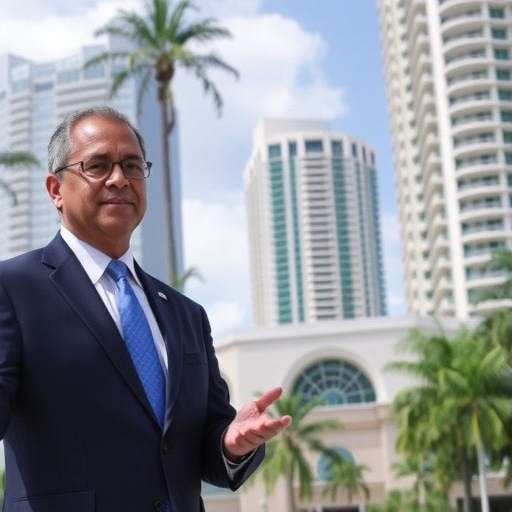Miami Mayor Francis Suarez Blasts New York’s Housing Policies Under Zohran Mamdani, Foresees Economic Exodus to Sunshine State
In a bold critique that underscores deepening divides between coastal cities, outgoing Miami Mayor Francis Suarez has issued a stark warning about New York City’s impending political shift under likely next mayor Zohran Mamdani. Suarez, a vocal proponent of free-market policies, lambasted Mamdani’s proposed housing policies as a recipe for economic stagnation, predicting they will accelerate an already surging migration from New York to Miami. Speaking at a recent economic forum in South Florida, Suarez declared, “New York’s flirtation with overreach will only push talent and capital southward, where innovation thrives without the chains of excessive regulation.” This comes as Mamdani, a progressive Democratic Socialist, edges closer to the mayoralty following a contentious primary win, with his agenda centered on aggressive rent controls and price caps that Suarez argues stifle growth.
- Suarez’s Fiery Rebuke: Linking Rent Controls to New York’s Decline
- Mamdani’s Bold Housing Agenda: A Progressive Push Against Skyrocketing Rents
- Migration Surge: How New York’s Policies Are Fueling Miami’s Renaissance
- National Echoes: Urban Policy Clash Signals Broader Ideological Battle
- Looking Ahead: Implications for Migrants, Markets, and Mayoral Races
The timing of Suarez’s remarks couldn’t be more poignant. As he prepares to step down after two terms marked by Miami’s transformation into a tech and finance hub, the mayor is positioning himself as a national voice against what he calls “socialist experiments” in urban governance. New York’s housing crisis, exacerbated by soaring rents and a shortage of affordable units, has long been a flashpoint. But with Mamdani’s rise, Suarez sees a tipping point. Data from the U.S. Census Bureau shows that between 2020 and 2023, over 100,000 New Yorkers relocated to Florida, with Miami-Dade County absorbing a significant portion—up 25% from pre-pandemic levels. Suarez links this trend directly to policies like the city’s existing rent stabilization laws, which he claims have led to a 15% decline in new housing construction since 2019, according to a report from the Urban Institute.
Suarez’s Fiery Rebuke: Linking Rent Controls to New York’s Decline
Francis Suarez didn’t mince words in his assessment of Zohran Mamdani’s housing policy blueprint. In a detailed op-ed published in the Miami Herald last week, the mayor dissected Mamdani’s platform, which includes expanding rent controls to cover 80% of the city’s rental market and imposing strict price controls on new developments. “These measures aren’t solutions; they’re sabotage,” Suarez wrote. He argued that such interventions distort the market, discouraging developers and driving up costs for everyone. To bolster his point, Suarez cited a study by the National Multifamily Housing Council, which found that cities with stringent rent controls experience 12% lower housing supply growth compared to unregulated markets.
Miami, by contrast, has embraced deregulation under Suarez’s leadership. Since 2018, the city has streamlined permitting processes, resulting in a 40% increase in housing starts, per local building department records. This approach, Suarez contends, has kept Miami’s median rent at $2,200—still high, but 20% below New York’s $2,800 average, according to Zillow data. “When government picks winners and losers, the losers are the families who can’t find a home,” Suarez told reporters after his forum speech. His criticism extends beyond housing to broader economic policies, including Mamdani’s push for higher corporate taxes, which Suarez warns could erode New York’s edge as a global financial center.
The personal stakes for Suarez add emotional weight to his words. As a Cuban-American whose family fled socialism in the 1960s, he frames his opposition as a defense of American opportunity. “I’ve seen what happens when central planning fails—it’s not just theory; it’s history,” he said. This narrative resonates in Miami, where recent migrants from high-tax states like New York and California have boosted the local economy by an estimated $5 billion annually, according to the Greater Miami Convention and Visitors Bureau.
Mamdani’s Bold Housing Agenda: A Progressive Push Against Skyrocketing Rents
Zohran Mamdani, the 32-year-old state assemblyman poised to become New York’s youngest mayor in decades, represents a generational shift in the city’s politics. Elected to the state legislature in 2020, Mamdani has built a reputation as a fierce advocate for tenant rights, drawing from his own immigrant roots as the son of Ugandan-Indian parents. His mayoral campaign, fueled by grassroots support in diverse neighborhoods like Queens and Brooklyn, promises to tackle New York’s housing policy woes head-on. With rents having surged 30% since 2020 amid inflation and post-COVID recovery, Mamdani argues that unchecked market forces have priced out working-class families.
Central to his plan is the “Fair Housing for All” initiative, which would cap annual rent increases at 3% for stabilized units and mandate 20% affordable housing in all new builds. Supporters, including tenant advocacy groups like the Association for Neighborhood and Housing Development, hail it as a lifeline. “New York’s housing market is broken—profiteers have turned homes into commodities,” Mamdani stated in a recent debate. He points to successes in places like San Francisco, where similar controls have preserved communities, though critics like Suarez counter that those cities suffer from even worse shortages.
Yet, Mamdani’s vision isn’t without controversy. Economists from the Manhattan Institute have warned that his policies could reduce investment by 18%, based on models from comparable cities. In New York, where 1.2 million rent-stabilized apartments already exist, expanding controls risks landlord exodus, potentially worsening the vacancy rate, which hovers at a dismal 2.5%. Mamdani dismisses such fears, vowing to pair regulations with public investment—proposing $10 billion in city bonds for social housing. As the November election approaches, polls from Siena College show Mamdani leading by 8 points, signaling voter fatigue with the status quo under current Mayor Eric Adams.
Migration Surge: How New York’s Policies Are Fueling Miami’s Renaissance
The ripple effects of New York’s housing policy debates are already visible in Miami’s skyline, where cranes dot the horizon and luxury condos rise alongside affordable units. Francis Suarez attributes this boom partly to disillusioned New Yorkers fleeing what they see as an increasingly hostile business climate. Internal migration data from the Florida Department of Economic Opportunity reveals that in 2023 alone, 45,000 people moved from New York to South Florida, contributing to a 7% population growth in Miami-Dade County. This influx has supercharged the local economy, with new businesses—many in fintech and crypto—registering at a rate 50% higher than five years ago.
Personal stories underscore the trend. Take Alex Rivera, a 35-year-old software engineer who left Brooklyn for Miami last year. “Rents there were eating 40% of my salary, and with Mamdani’s ideas, I saw no relief,” Rivera shared in an interview. Now, he pays 25% less for a similar apartment and enjoys no state income tax—a stark contrast to New York’s 10.9% top rate. Suarez has capitalized on these narratives, launching a “Miami Welcomes You” campaign that highlights the city’s pro-growth stance. The initiative includes incentives like expedited business licenses for transplants, drawing praise from chambers of commerce but ire from New York officials who accuse Suarez of poaching talent.
Economically, the benefits are quantifiable. A report by the Beacon Council, Miami’s economic development arm, estimates that New York migrants added $2.3 billion in taxable income to Florida in 2023. Sectors like real estate have seen a 22% uptick in sales, while hospitality thrives on the influx of remote workers. However, challenges loom: Miami’s rapid growth has strained infrastructure, with traffic congestion up 15% and public schools nearing capacity. Suarez acknowledges these pains but insists they’re growing pains worth enduring, unlike New York’s “self-inflicted wounds” from overregulation.
National Echoes: Urban Policy Clash Signals Broader Ideological Battle
The feud between Francis Suarez and Zohran Mamdani transcends local politics, illuminating a national divide over housing policy in America’s cities. As urban centers grapple with affordability crises—exacerbated by remote work and inflation—debates rage between deregulation advocates like Suarez and interventionists like Mamdani. In Miami, Suarez’s model has attracted endorsements from figures like Florida Governor Ron DeSantis, who touts the state as a “refuge for opportunity.” Meanwhile, Mamdani draws inspiration from progressive mayors in cities like Los Angeles and Boston, where similar policies aim to curb gentrification.
Experts weigh in on both sides. Dr. Elena Vasquez, a housing economist at Columbia University, notes that while rent controls provide short-term relief, they often lead to long-term supply shortages. “New York’s experiment could inform the nation, but at what cost?” she asked in a recent podcast. Conversely, urban planner Jamal Thompson from the NYU Furman Center argues that without controls, inequality deepens. “Miami’s boom benefits the wealthy; New York’s fight is for the vulnerable.” Statistics bear this out: New York’s poverty rate stands at 17%, double Miami’s 8.5%, per U.S. Census figures.
Politically, Suarez’s critique positions him for a potential gubernatorial run or national role in a Republican administration, leveraging his anti-socialist rhetoric. Mamdani, if elected, could galvanize the Democratic left, pushing for federal housing reforms like those in the stalled Build Back Better agenda. Tensions between Miami and New York aren’t new—past spats over sports rivalries pale compared to this policy showdown—but Suarez’s warnings amplify the stakes.
Looking Ahead: Implications for Migrants, Markets, and Mayoral Races
As Zohran Mamdani’s campaign heats up, the eyes of urban policymakers nationwide turn to New York, wondering if his housing policy revolution will inspire or repel. Francis Suarez, now a private citizen but influential voice, vows to continue advocating for Miami’s model, potentially through a think tank he’s founding on urban economics. For migrants, the choice is clear: New York’s bold reforms offer security for some, while Miami’s dynamism promises prosperity for others. Market analysts predict that if Mamdani wins and implements his agenda, interstate migration could spike another 20%, per projections from the Migration Policy Institute.
In the coming months, expect more clashes. Suarez has scheduled debates with progressive leaders, while Mamdani’s team is courting Florida transplants for testimonials on New York’s strengths. Ultimately, this rivalry could reshape how cities balance equity and growth, with Miami and New York as competing laboratories. For residents in both hubs, the outcome will dictate not just where they live, but how they thrive—or struggle—in America’s evolving urban landscape.










